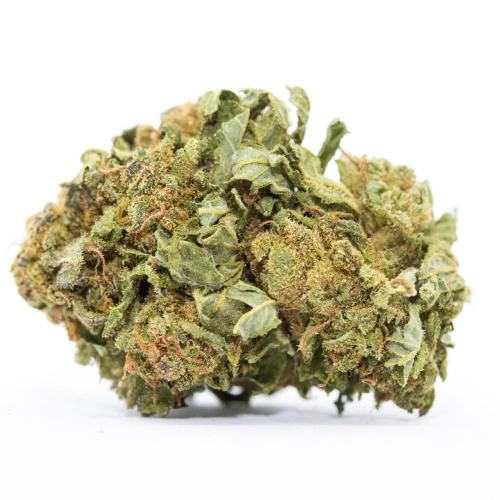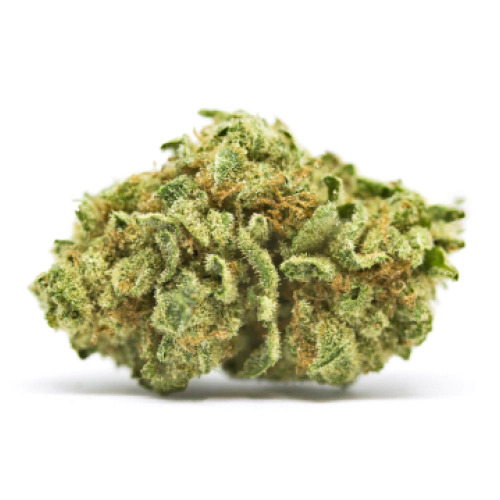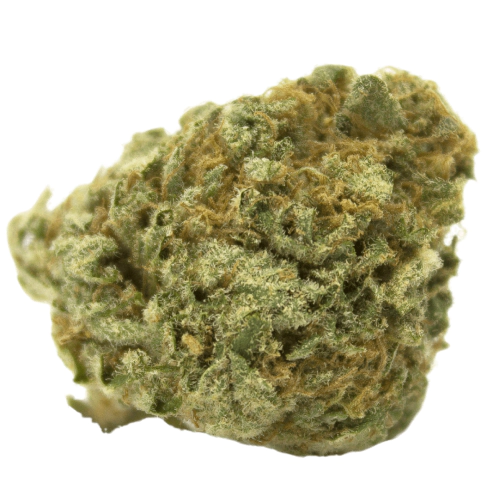Pop Tarts
Cannabinoid THC Dominant
THC 17.67 - 21%
CBD 2.36 - 2.61%
Effect Happy
Side Effect Dry eyes
Flavor Lemon
Pop Tarts Strain Information
THC
CBD
Potency
Pop Tarts is the result of combining parent strains SOGA and Lemon Cake. This is a Sativa-dominant strain with a Sativa/Indica ratio of 65/35. This is a potent marijuana strain that can have a THC to CBD ratio of 3:1, with 18-22% of THC and 2.5-7% of CBD in some batches. With its Sativa characteristics, it energizes the consumer, and its sweet flavors are the icing on the cake.
Taste and Aroma of Pop Tarts Strain
The prominent notes you will sense in the aroma, as well as the taste, of this cannabis are those of lemon and other citrus fruits. The terpene profile of this strain makes for an overall sweet and slightly sour flavor. You'll have a pleasant taste whether you like to smoke the flower directly or infuse it into some cannabutter for using in baked treats.
The following terpenes are present in this cultivar:
- Myrcene
- Limonene
- Linalool
- Caryophyllene
Myrcene gives Pop Tarts weed strain some creamy notes of butter as well as a sweet earthiness. Limonene, Linalool, and Caryophyllene all come together for a strong punch of lemon and citrus. The resulting flavors are very lemony with some nice sweet earthy and creamy butter notes.
Effects and Uses
Consuming this weed will make you instantly energized and uplifted. It envelopes the mind in a euphoric high that makes you want to get moving right away. Consumers report feeling happy and giggly as well as feeling a creative boost. All of this makes for a good daytime smoking session when you need the energy to take on the upcoming day. With its high THC content, though, it's not the best choice for beginners.
Pop Tarts strain doesn't have too many side effects other than the usual thirst and dry mouth. Some consumers report getting headaches, though, so be sure to be careful with the doses. On the medical side of things, Pop Tarts can be used to alleviate symptoms associated with chronic pain, cramps, fatigue, stress, and depression.
Information About Growing
Growing Pop Tarts strain to get your hands on its oversized buds with thick orange hairs will take between 54 and 64 days. It doesn't grow too tall, with a maximum height of around 60 inches. You can expect to get a moderate yield of around 400 g/m2, whether grown indoors or outdoors.
Side Effects
Simply let us know how this strain tastes or write a detailed review.
Pop Tarts Strain Cannabinoids
| THC | Tetrahydrocannabinol, or THC, is a major cannabis chemical compound. It is a psychoactive element that stimulates dopamine release and induces euphoria or happiness. THC-rich strains may be helpful with such conditions as lack of appetite, chronic pains , etc. It is considered to be the primary active marijuana component. | 17.67 - 21% |
| CBD | Cannabidiol, or CBD, is a major compound in cannabis, which is non-psychoactive. It is also proved to counteract the side effects of the second major component THC. CBD is widely used for medicinal purposes in rubs, oils and so on. It is helpful in muscle pain cases, may treat arthritis and migraines. Even Greeks used it against pain, while Queen Victoria applied it to get rid of menstrual cramps. | 2.36 - 2.61% |
| CBC | Cannabichromene, or CBC, is a minor cannabinoid, meaning that its quantity in cannabis is quite little. Though it has the same origin as CBD and THC, it is different in functions. Without any psychoactive effects, it is an efficient cannabis compound in combating acne and depression. CBC produces analgesic, antibacterial and anti-inflammatory effects. | 0.37 - 0.49% |
| CBG | Cannabigerol, or CBG, is one of the minor cannabis compounds in adult plants. On the other hand, young ones contain a lot of this antibacterial and anti-inflammatory component. During the growth, CBG is converted into different cannabinoids, mostly THC and CBD. The compound itself increases appetite and decreases eye pressure. | 0.02 - 0.09% |
| CBN | Cannabinol, or CBN, is a trace element in cannabis that is considered to be mildly psychoactive. It appears from oxidation THC, exposed to light and heat. CBN is mostly contained in old cannabis and in traditional hashish. It is effective against insomnia, bacterial infections and appetite loss. | 0.07 - 0.11% |
| THCV | Tetrahydrocannabivarin, or THC-V, is a compound contained in cannabis in trace amounts. Even though it is close to THC molecularly, it is different in effects. This compound may be psychoactive only in large amounts. THC-V reduces blood sugar, controls appetite, stimulates bone growth, etc. African Sativa strains are the richest in THC-V. | 0.03 - 0.15% |
Pop Tarts Terpene Profile
| Myrcene | Myrcene (also known as β-myrcene) is one of the most common terpenes found in cannabis, representing more than 20% of the modern marijuana terpene profile. Myrcene has a distinct earthy, musky flavor, resembling cloves. It is responsible for calming and soothing effects of weed. Myrcene is also found in hops, thyme, mango, lemongrass, guava melon. | 0.07% |
| Geraniol | Geraniol is a terpene initially contained in geraniums, as well as lemongrass, lemon peels, roses, blueberries, and carrots. The aroma is a sweet rose scent with notes of citrus. Geraniol features anti-inflammatory, antibacterial, antifungal, and neuroprotectant properties. It's rumored to have side effects such as allergic contact dermatitis or sensitive skin irritation. | 0.09% |
| Humulene | Humulene (also known as α-humulene) is one of the major terpenes found in cannabis, contributing to woody, earthy, spicy, herbaceous, and, mainly, floral aromas of cannabis. Used in modern medicine, humulene offers anti-inflammatory, antibacterial, and appetite suppressant effects, which have been well-researched by pharmaceutical companies. | 0.01% |
| Limonene | Limonene (also known as d-limonene) is the second most common terpene in nature and the third most common terpene in cannabis. It has a powerful citrus aroma and can be found in all citruses, including lemons, oranges, grapefruits, limes, juniper, etc. Limonene is known to elevate moods and provide anxiety, depression, and stress relief. | 0.31% |
| Linalool | Linalool (also known as beta linalool, linalyl alcohol, linaloyl oxide, and p-linalool) is one of the rarest terpenes found in cannabis, mostly in small quantities. Linalool is known for its spicy and lavender aroma, bringing relaxation and calming effects. It is also said to provide anti-inflammatory and analgesic properties that can be useful for athletes. | 0.23% |
| Bisabolol | Bisabolol (also known as α-Bisabolol or levomenol) is a lesser-known terpene found in cannabis. It contributes to anti-inflammatory, anti-irritant, antioxidant, anti-microbial, and analgesic properties of weed strains containing bisanol. Attentive smokers would be able to catch a nutty, fruity scent with herbal and floral undertones, with a tender trace of coconut. | 0.11% |
| Terpineol | Terpineol (also known as alpha-terpineol or a-terpineol) is a terpene naturally occurring in more than 150 plants, including lilacs, lime blossoms, eucalyptus sap, and pines. Among the therapeutic qualities are anti-inflammatory, antioxidant, antitumor, and antimicrobial. In cannabis, terpineol boasts the distinctive pine smoke aroma and causes a relaxing, sedative effect. | 0.01% |
| Valencene | Valencene is a terpene that got its name from Valencia oranges - a fruit where It's initially found. Valencene offers citrusy, sweet aromas, with flavors having notes of oranges, grapefruits, tangerines, and, occasionally, fresh herbs or freshly cut wood. Citrus aromas, frequently found in a wide variety of cannabis strains, are contributed to by valencene, which is known for anti-inflammatory and insect repelling properties. | 0.06% |
| Phellandrene | Phellandrene (also known as alpha- and beta-phellandrene) is one of the rare terpenes found in cannabis with antihyperalgesic and antidepressive properties. Phellandrene contributes to a minty, woody, and mildly citrus aroma in cannabis. Previously confused with limonene and pinene, phellandrene was eventually distinguished as a separate terpene common for eucalyptus. Also, it could be found in mint, dill, black pepper, cinnamon, parsley, pine, and lavender. | 0.07% |
| Caryophyllene | Caryophyllene (also known as beta or b caryophyllene) is a terpene found in many herbs and spices, such as black pepper, basil, rosemary, and oregano. Cannabis high in caryophyllene delivers a strong spicy, peppery aroma, resembling cinnamon and cloves. Caryophyllene offers potent anti-inflammatory and sedative effects. | 0.05% |
| Total terpenes content | 1.01% |
Growing Info
Similar Strains
THC 15.67 - 19%
CBD 0.39 - 0.74%
Effect Sleepy
Flavor Citrus

THC 1.25 - 2%
CBD 0.01 - 0.14%
Effect Hungry
Flavor Orange
THC 16.5 - 18.75%
CBD 0.18 - 0.35%
Effect Giggly
Flavor Spicyherbal
THC 22 - 25.33%
CBD 0.44 - 0.75%
Effect Euphoric
Flavor Spicyherbal
THC 10.5 - 12%
CBD 0.01 - 0.25%
Effect Giggly
Flavor Tea
THC 17.99 - 18.01%
CBD 0.68 - 0.84%
Effect Happy
Flavor Tobacco

THC 16 - 9.5%
CBD 0.11 - 0.96%
Effect Giggly
Flavor Apricot
THC 16 - 19%
CBD 0.65 - 0.88%
Effect Sleepy
Flavor Cheese
THC 15 - 17%
CBD 0.48 - 0.64%
Effect Hungry
Flavor Lavender
THC 19 - 23.5%
CBD 0.39 - 0.4%
Effect Euphoric
Flavor Spicyherbal
THC 20 - 20%
CBD 0.53 - 0.82%
Effect Focused
Flavor Pine










Be the first and share your opinion
Write a Review